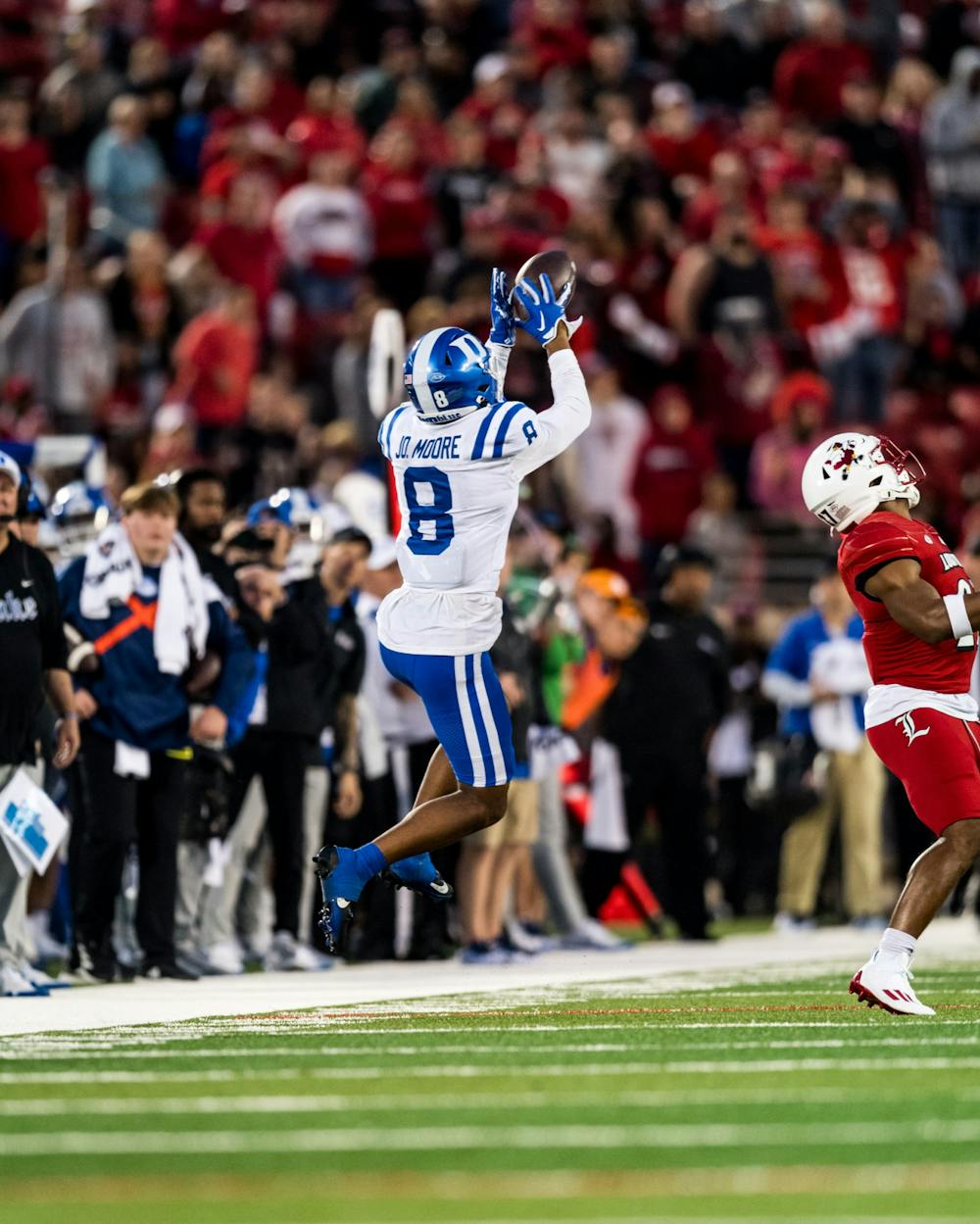LOUISVILLE, Ky.—In Duke’s first two losses this season, most of the Blue Devil faithful put an asterisk beside the result.
If Duke stopped Notre Dame on a crucial fourth-and-16, the Blue Devils remain undefeated and junior quarterback Riley Leonard doesn’t get injured. If Leonard is fully healthy and doesn’t get reinjured against Florida State, maybe Duke pulls off the improbable upset in Tallahassee, Fla.
There were no ifs, ands or buts Saturday afternoon, though. Louisville dominated the game from the jump, running through the Blue Devil defense at will and stifling any hope of Duke breaking through offensively.
This game revealed something that has been a pattern all season, hidden because of Leonard’s scrambling heroics, the emergence of graduate running back Jordan Waters and a lights-out defense. The passing game has been inconsistent, to say the least. Marked by dropped passes and inaccurate throwing, this season has been worse than last year through the air.
“For us to be successful, we have to be able to throw and catch the football,” said head coach Mike Elko after the loss. “It was an inefficient performance at every single level.”
To be fair, Duke hasn’t really needed to pass the ball too much this season. But in times when the offense has been stagnant — the first halves against Notre Dame and Clemson, the majority of the N.C. State game and this entire game — it has been the passing attack that did not step up.
On the first passing play of the game, Leonard fired a ball to a wide-open Jalon Calhoun, who dropped it. The usually sure-handed redshirt senior wide receiver wasn’t able to haul in the reception, and while it was one play, it was indicative of the rest of the game.
“Everything that we're doing is kind of self-inflicted, so we need to look internally,” said junior wide receiver Jordan Moore. “I need to be better, the receivers need to be better, everybody just needs to be better.”
The running game was stagnant for one of the first times all season, as graduate student Jordan Waters and junior Jaquez Moore combined for 38 yards, and the Blue Devils rushed for a season-low 51 yards. In addition, the Louisville front seven is elite, second in the conference in rushing yards allowed per game. It was known before the game that stifling Duke’s running game would be the plan for the team.
“We just never could get in any kind of rhythm at all on offense, running the ball, throwing the ball, nothing,” Elko said.
In order for the Blue Devils to be a potent offensive threat, there needs to be some semblance of a successful passing attack — a backup plan for a slow ground game. Duke is dead last in the conference in passing yards per game and completions, and is 10th in completion percentage.
Leonard was noticeably more mobile in this game than against Florida State, but it really didn’t matter. He has been a phenomenal asset for this team, but this season, it’s been with his legs. Outside of redshirt freshman Henry Belin IV’s 69-yard strike to Calhoun in Duke’s 24-3 victory against N.C. State, the deep ball has been non-existent in this offense.
“We also have to be able to make our reads and our progressions, and we didn't do that at times tonight,” Elko said.
An additional factor was the pressure Leonard faced, limiting his time to throw and for receivers to create separation. Starting offensive lineman Graham Barton did not play and another starter, Jacob Monk, exited the game with a first-quarter injury, so Leonard was under distress for the majority of his dropbacks. Regardless, the offense was not in sync throughout the game, and the chemistry between Leonard and his receivers was off.
The Fairhope, Ala., native finished 9-for-23 through the air and over the past four games, both quarterbacks are a combined 33-for-84. This shows that it has not just been the deep ball that's an issue, but even simple slants and screens are hard to come by. Towards the end of the game, when the Cardinal secondary switched to softer coverage and allowed Duke to move the ball, the Blue Devils still weren’t able to score and wide receiver Sahmir Hagans dropped a ball on Leonard’s final possession.
“We just came out flat, we didn't really play to the level that we were able to,” Moore said. “We gotta get back to the basics, do exactly what our coaches have taught us to do.”
The good news is that Duke has the personnel. The Blue Devil fans last year saw Leonard’s throwing capabilities, and the team has a number of elite receivers who are certainly competent in gaining separation. This is largely the same offense from a season ago, so the chemistry is there, even if it hasn’t been visible for a large part of the season.
It’s important to not overreact to the result, because mental lapses and flat games happen, especially at the collegiate level. This inefficiency has been thematic though this year’s Duke team, but with an improvement, this offense can be dangerous again.
“Every level of our offense should feel very completely like that's not good enough, from the head coach to the offensive coaches, to the players, to everybody, we should feel like we need to respond and I believe we will,” Elko said.
The Blue Devils have a chance to prove this shortly, returning to Durham to face Wake Forest Nov. 2.
Get The Chronicle straight to your inbox
Signup for our weekly newsletter. Cancel at any time.

Ranjan Jindal is a Trinity sophomore and sports editor of The Chronicle's 120th volume.

